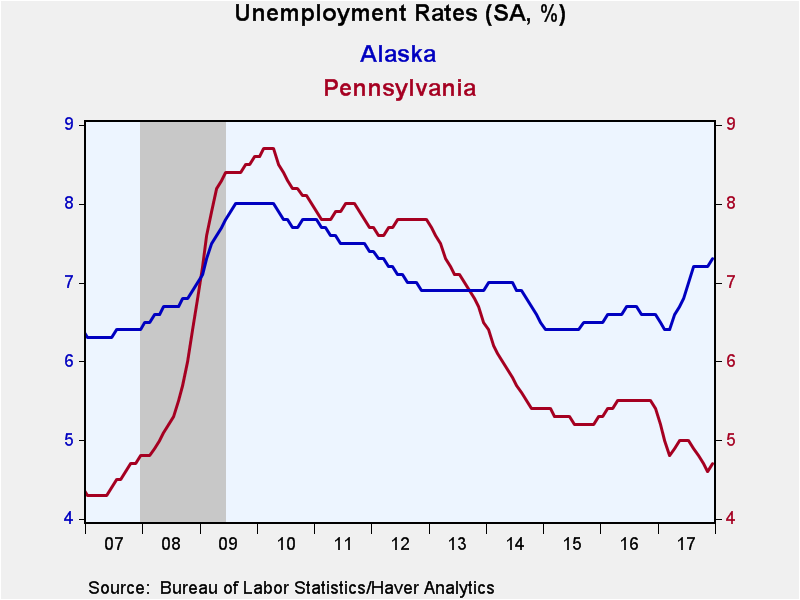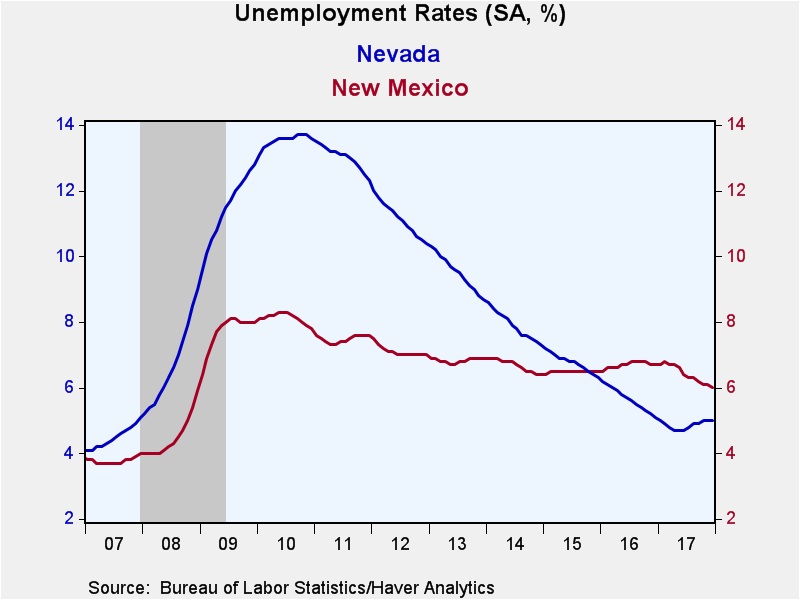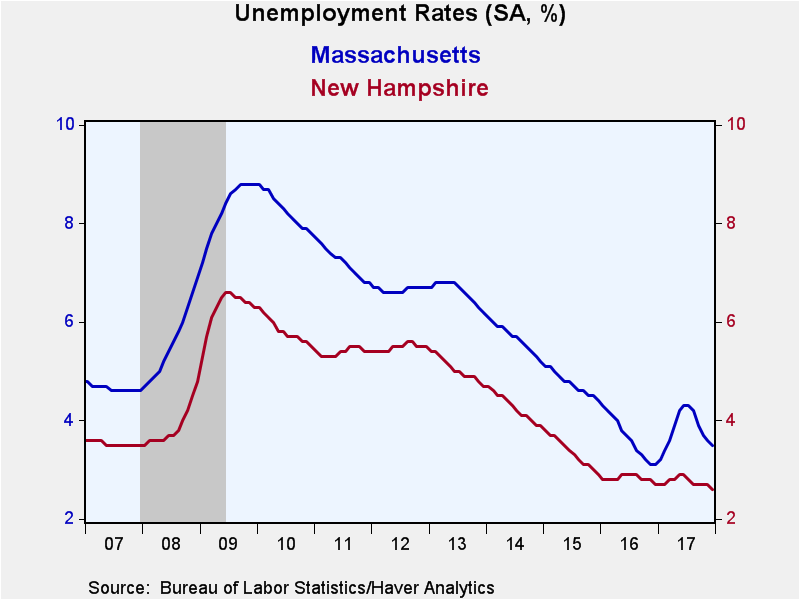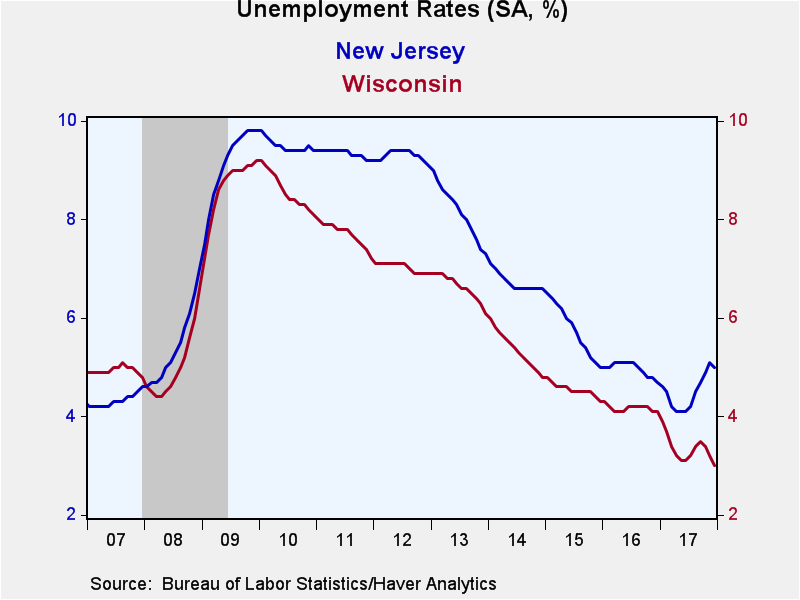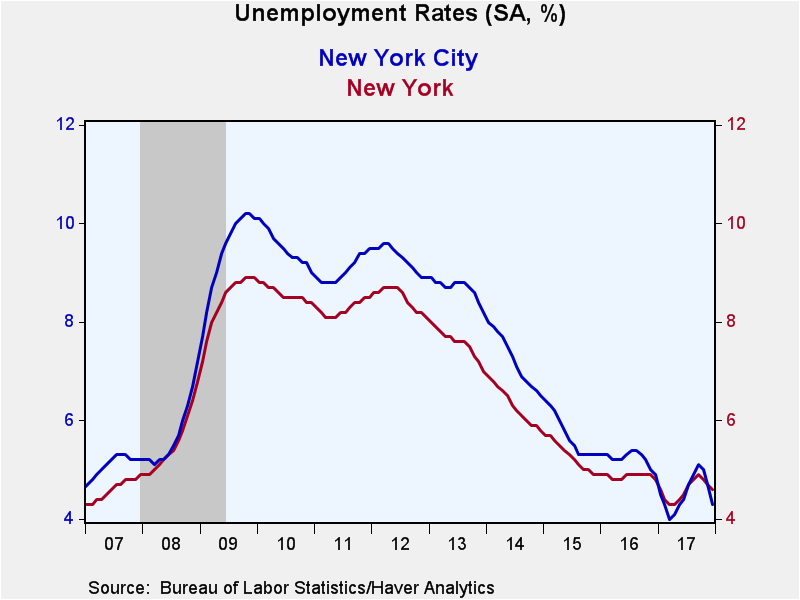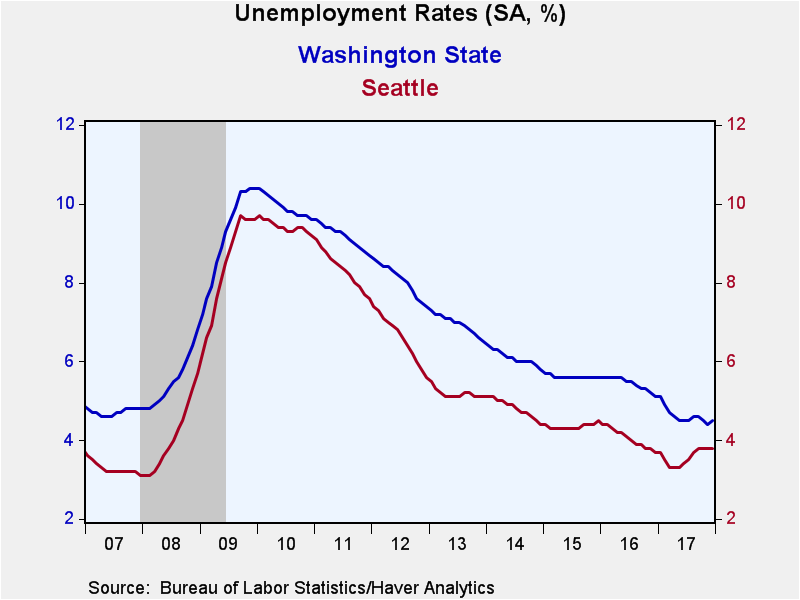 Global| Jan 23 2018
Global| Jan 23 2018U.S. State Unemployment Ranges Widely
by:Tom Moeller
|in:Economy in Brief
Summary
As the unemployment rate declined during December to a 10-year low of 4.1%, it continued to vary greatly amongst the states. At the high end were two states which realized unemployment at or above 6.0%. At the low end, were several [...]
As the unemployment rate declined during December to a 10-year low of 4.1%, it continued to vary greatly amongst the states. At the high end were two states which realized unemployment at or above 6.0%. At the low end, were several states below 3.0%.
Alaska's unemployment rate set the nation's high at 7.3% as it rose from 6.4% early in the year. Unemployment surged nearly twelve percent by the end of the year even as labor force growth cooled. New Mexico's jobless rate also remained elevated at 6.0%. It nevertheless fell from 6.7% early in the year. Unemployment growth fell sharply during the year as labor force growth was moderate. Nevada's unemployment rate also was a high 5.0% as unemployment eased while the labor force surged. Pennsylvania's jobless rate also held high at 4.7%. Unemployment was little changed y/y but the labor force fell.
At the low end of the range in unemployment stood Hawaii at 2.0%. Employment eased 0.5% y/y while the labor force declined modestly. New Hampshire also had low unemployment at 2.6%, but it reflected declines in employment, unemployment and the labor force. Maine's jobless rate remained at its record-low of 3.0% as employment grew a diminished 1.5% y/y against 0.7% y/y growth in the labor force. In Massachusetts, after a run-up to 4.3% early in the year, a fall to a 3.5% jobless rate reflected 1.3% y/y growth in jobs and 1.8% growth in the labor pool.
Amongst other large states, New Jersey's 5.0% rate of unemployment reflected slight declines in both employment & the size of the labor force. Texas unemployment at 3.9% occurred as employment grew 2.4% y/y and the labor force expanded 1.4% y/y. Similarly, North Carolina's 4.5% unemployment reflected 1.4% y/y growth in employment and a 0.6% y/y rise in the labor force. At the low end of the range amongst large states was Wisconsin which experienced 3.0% unemployment as employment rose 2.9% y/y with 1.8% y/y growth in the labor force.
Within large cities, New York City's jobless rate fell to 4.3% from a 2009 high of 10.2%, reflecting 3.1% employment growth this past year, and a 2.5% y/y gain in the labor force. Unemployment in New York state was a slightly higher 4.6%, down from a 2009 high of 8.9%. Unemployment around Chicago at 5.1% was up from its 4.2% low earlier in the year, compared to 4.8% in all of Illinois. The city's low jobless rate reflected employment that was little changed this past year set against a 0.2% y/y decline in the labor force. In California, the jobless rate was reduced to 4.3% compared to 4.5% around Los Angeles. In Washington state, 4.5% unemployment compared to 3.8% around Seattle where a 1.5% y/y gain in employment accompanied a 1.6% rise in the labor force.
State unemployment figures are available in Haver's EMPLRdatabase.
| Dec | Nov | 2017 | 2016 | 2015 | Labor Force | |
|---|---|---|---|---|---|---|
|
Total U.S. Unemployment Rate (%) |
4.1 | 4.1 | 4.4 | 4.9 | 5.3 | 159.5 million |
|
Ten States With Highest Jobless Rate |
||||||
| Alaska | 7.3 | 7.2 | 6.9 | 6.6 | 6.4 | 0.4 |
| New Mexico | 6.0 | 6.1 | 6.4 | 6.7 | 6.5 | 0.9 |
| West Virginia | 5.5 | 5.3 | 5.0 | 6.0 | 6.7 | 0.8 |
| Nevada | 5.0 | 5.0 | 4.9 | 5.6 | 6.8 | 1.4 |
| Illinois | 4.8 | 4.9 | 4.9 | 5.9 | 5.9 | 6.5 |
| Pennsylvania | 4.7 | 4.6 | 4.9 | 5.5 | 5.3 | 6.4 |
| Mississippi | 4.6 | 4.8 | 5.1 | 5.9 | 6.3 | 1.3 |
| Washington | 4.5 | 4.4 | 4.6 | 5.4 | 5.6 | 3.6 |
| Georgia | 4.4 | 4.3 | 4.8 | 5.4 | 5.9 | 4.9 |
| California | 4.3 | 4.6 | 4.8 | 5.4 | 6.2 | 19.1 |
| Ten States With Lowest Jobless Rate | ||||||
| Arkansas | 3.7 | 3.7 | 3.6 | 4.0 | 5.0 | 1.3 |
| Massachusetts | 3.5 | 3.6 | 3.8 | 3.7 | 4.8 | 3.6 |
| South Dakota | 3.5 | 3.5 | 3.1 | 2.8 | 3.1 | 0.5 |
| Indiana | 3.4 | 3.7 | 3.6 | 4.5 | 4.8 | 3.3 |
| Minnesota | 3.1 | 3.2 | 3.7 | 3.9 | 3.8 | 3.0 |
| Colorado | 3.1 | 2.9 | 2.6 | 3.3 | 3.8 | 2.9 |
| Maine | 3.0 | 3.3 | 3.4 | 3.9 | 4.3 | 0.7 |
| Iowa | 2.8 | 2.9 | 3.1 | 3.7 | 3.8 | 1.7 |
| New Hampshire | 2.6 | 2.7 | 2.8 | 2.8 | 3.4 | 0.7 |
| Hawaii | 2.0 | 2.1 | 2.6 | 3.0 | 3.6 | 0.7 |
| Jobless Rate In Other Selected Large States | ||||||
| New Jersey | 5.0 | 5.1 | 4.5 | 5.0 | 5.8 | 4.5 |
| Ohio | 4.7 | 4.8 | 5.0 | 5.0 | 4.9 | 5.7 |
| Michigan | 4.7 | 4.6 | 4.5 | 5.0 | 5.4 | 4.8 |
| New York | 4.6 | 4.7 | 4.6 | 4.9 | 5.3 | 9.6 |
| Arizona | 4.5 | 4.3 | 4.9 | 5.2 | 5.9 | 3.2 |
| North Carolina | 4.5 | 4.3 | 4.5 | 5.1 | 5.7 | 4.9 |
| Maryland | 4.0 | 3.9 | 4.0 | 4.3 | 5.0 | 3.2 |
| Texas | 3.9 | 3.8 | 4.4 | 4.7 | 4.4 | 13.3 |
| Florida | 3.7 | 3.6 | 3.7 | 4.9 | 5.3 | 9.8 |
| Wisconsin | 3.0 | 3.2 | 3.3 | 4.2 | 4.5 | 3.1 |
Tom Moeller
AuthorMore in Author Profile »Prior to joining Haver Analytics in 2000, Mr. Moeller worked as the Economist at Chancellor Capital Management from 1985 to 1999. There, he developed comprehensive economic forecasts and interpreted economic data for equity and fixed income portfolio managers. Also at Chancellor, Mr. Moeller worked as an equity analyst and was responsible for researching and rating companies in the economically sensitive automobile and housing industries for investment in Chancellor’s equity portfolio. Prior to joining Chancellor, Mr. Moeller was an Economist at Citibank from 1979 to 1984. He also analyzed pricing behavior in the metals industry for the Council on Wage and Price Stability in Washington, D.C. In 1999, Mr. Moeller received the award for most accurate forecast from the Forecasters' Club of New York. From 1990 to 1992 he was President of the New York Association for Business Economists. Mr. Moeller earned an M.B.A. in Finance from Fordham University, where he graduated in 1987. He holds a Bachelor of Arts in Economics from George Washington University.


